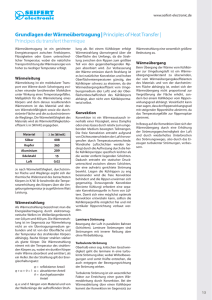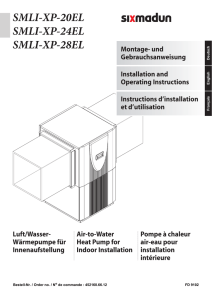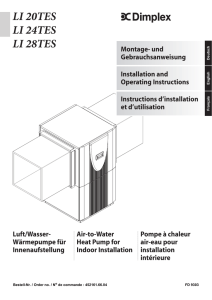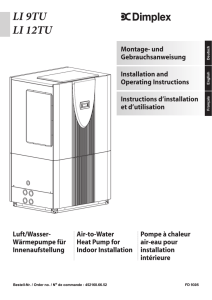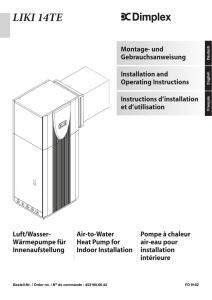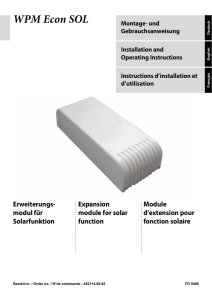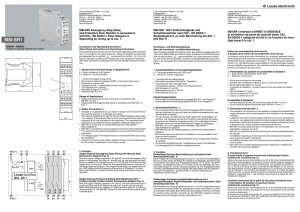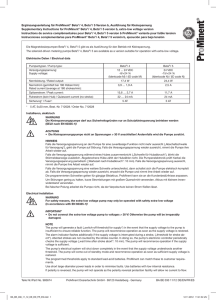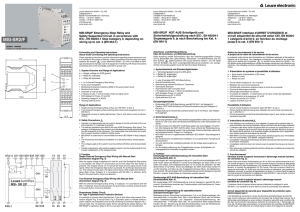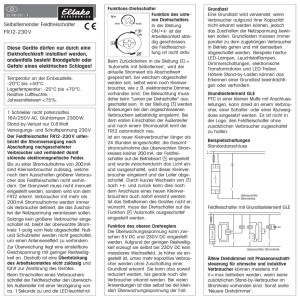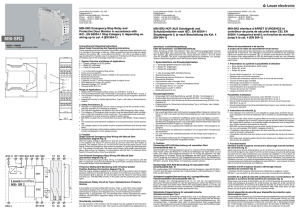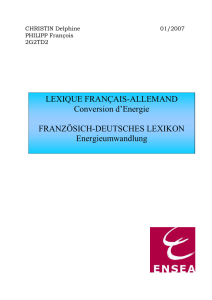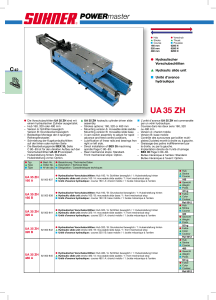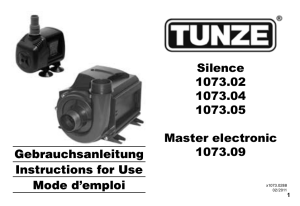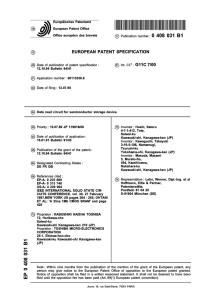HWK 332 Econ_FD9004_DE_GB-FR.book
publicité
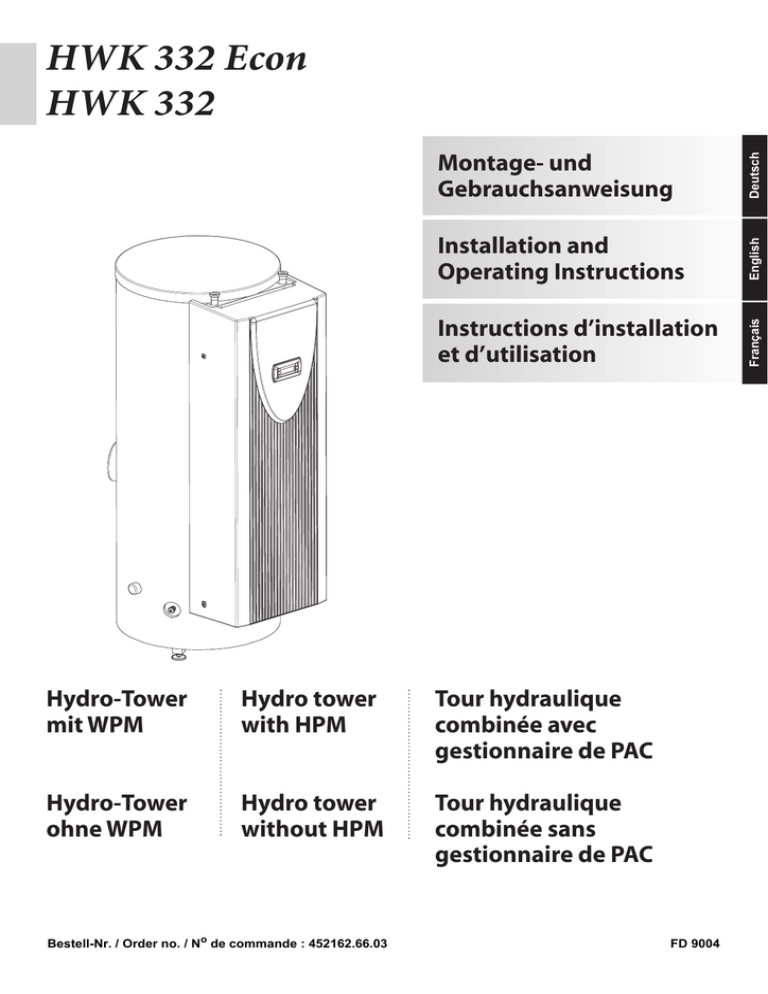
Installation and Operating Instructions English Instructions d’installation et d’utilisation Français Montage- und Gebrauchsanweisung Hydro-Tower mit WPM Hydro tower with HPM Tour hydraulique combinée avec gestionnaire de PAC Hydro-Tower ohne WPM Hydro tower without HPM Tour hydraulique combinée sans gestionnaire de PAC Bestell-Nr. / Order no. / No de commande : 452162.66.03 Deutsch HWK 332 Econ HWK 332 FD 9004 Inhaltsverzeichnis 1 Bitte sofort lesen ........................................................................................................................ DE-2 2 Verwendungszweck des Hydro-Towers................................................................................... DE-2 2.1 Anwendungsbereich ............................................................................................................................ DE-2 2.2 Allgemeine Eigenschaften ................................................................................................................... DE-2 3 Lieferumfang............................................................................................................................... DE-2 3.1 Grundgerät........................................................................................................................................... DE-2 3.2 Schaltkasten ........................................................................................................................................ DE-3 3.3 Wärmepumpenmanager ...................................................................................................................... DE-3 4 Transport..................................................................................................................................... DE-3 5 Aufstellung.................................................................................................................................. DE-3 5.1 Allgemein ............................................................................................................................................. DE-3 5.2 Schall ................................................................................................................................................... DE-3 6 Montage....................................................................................................................................... DE-4 6.1 Allgemein ............................................................................................................................................. DE-4 6.2 Heizungsseitiger Anschluss................................................................................................................. DE-4 6.3 Elektrischer Anschluss......................................................................................................................... DE-4 7 Inbetriebnahme........................................................................................................................... DE-4 7.1 Allgemein ............................................................................................................................................. DE-4 7.2 Vorbereitung ........................................................................................................................................ DE-5 7.3 Vorgehensweise .................................................................................................................................. DE-5 8 Reinigung / Pflege ...................................................................................................................... DE-5 8.1 Pflege................................................................................................................................................... DE-5 8.2 Reinigung Heizungsseite ..................................................................................................................... DE-5 8.3 Korrosionsschutzanode ....................................................................................................................... DE-5 9 Störungen / Fehlersuche ........................................................................................................... DE-5 10 Außerbetriebnahme / Entsorgung ............................................................................................ DE-5 11 Geräteinformation ...................................................................................................................... DE-6 Anhang / Appendix / Annexes ............................................................................................................ A-I DE-1 Deutsch 1.1 Wichtige Hinweise ............................................................................................................................... DE-2 1.2 Gesetzliche Vorschriften und Richtlinien ............................................................................................. DE-2 1 1 Bitte sofort lesen 1.1 Wichtige Hinweise Deutsch ACHTUNG! Das Gerät ist nicht für Frequenzumrichterbetrieb geeignet. ACHTUNG! Verwenden Sie nie sand-, soda-, säure- oder chloridhaltige Putzmittel, da diese die Oberfläche angreifen. Personen, insbesondere Kinder, die aufgrund ihrer physischen, sensorischen oder geistigen Fähigkeiten oder ihrer Unerfahrenheit oder Unkenntnis nicht in der Lage sind, das Gerät sicher zu benutzen, sollten dieses Gerät nicht ohne Aufsicht oder Anweisung durch eine verantwortliche Person benutzen. Kinder sollten beaufsichtigt werden, um sicherzustellen, dass sie nicht mit dem Gerät spielen. 2 Verwendungszweck des Hydro-Towers ACHTUNG! Vor Öffnen des Gerätes ist sicherzustellen, dass alle Stromkreise spannungsfrei geschaltet sind. ACHTUNG! Hydro-Tower und Transportpalette sind mittels Schrauben miteinander verbunden. ACHTUNG! Arbeiten an der Anlage dürfen nur vom autorisierten und sachkundigen Kundendienst durchgeführt werden. 2.1 Anwendungsbereich Der Hydro-Tower bildet die Schnittstelle zwischen einer nicht reversiblen Wärmepumpe und dem Heiznetz im Gebäude. Der Hydro-Tower beinhaltet alle hydraulischen Komponenten die zwischen Wärmeerzeugung und Wärmeverteilung mit einem ungemischten Heizkreis benötigt werden. Ein doppelt differenzdruckloser Verteiler in Kombination mit einem Pufferspeicher ergibt eine energetisch optimale hydraulische Einbindung des Wärmeerzeugers und der Wärmeverbraucher. Die Funktionssicherheit des Sicherheitsventils ist in regelmäßigen Abständen zu überprüfen. Eine jährliche Wartung durch eine Fachfirma wird empfohlen. Das Gerät ist nicht für Frequenzumrichterbetrieb geeignet. Der Ablauf des Sicherheitsventils sollte einsehbar in einen Schmutzwasser-Abfluss führen. 2.2 ACHTUNG! Allgemeine Eigenschaften Der Errichter der Heizanlage muss eigenverantwortlich prüfen, ob ein zusätzliches Ausdehnungsgefäß erforderlich ist. Geringer Installationsaufwand Durch eine vernünftige Betriebsweise sind erhebliche Energieeinsparungen möglich. Im Wärmepumpenbetrieb sollte die Heizwassertemperatur so gering wie nötig sein. Die Auslegung der Systemtemperatur obliegt dem Planer der Heizungsanlage. Anschlussfertig, enthält alle wesentlichen Komponenten über Pumpen, Absperrungen, Sicherheitstechnik und Wärmepumpenmanager (HWK 332 Econ) Bei Installation einer Fußbodenheizung sollte ein sinnvoller Wert für die maximale Vor- bzw. Rücklauftemperatur im Wärmepumpenregler eingestellt werden. Die Position des Temperaturfühlers ist hierbei zu beachten. 1.2 Gesetzliche Vorschriften und Richtlinien Diese Wärmepumpe ist gemäß Artikel 1, Abschnitt 2 k) der EGRichtlinie 2006/42/EC (Maschinenrichtlinie) für den Gebrauch im häuslichen Umfeld bestimmt und unterliegt damit den Anforderungen der EG-Richtlinie 2006/95/EC (Niederspannungsrichtlinie). Sie ist damit ebenfalls für die Benutzung durch Laien zur Beheizung von Läden, Büros und anderen ähnlichen Arbeitsumgebungen, von landwirtschaftlichen Betrieben und von Hotels, Pensionen und ähnlichen oder anderen Wohneinrichtungen vorgesehen. Bei der Konstruktion und Ausführung des Hydro-Towers wurden alle entsprechenden EG-Richtlinien, DIN- und VDE-Vorschriften eingehalten (siehe CE-Konformitätserklärung). Beim elektrischen Anschluss des Hydro-Towers sind die entsprechenden VDE-, EN- und IEC-Normen einzuhalten. Außerdem müssen die Anschlussbedingungen der Versorgungsnetzbetreiber beachtet werden. Beim Anschließen der Heizungsanlage sind die einschlägigen Vorschriften einzuhalten. Gute Zugänglichkeit aller Komponenten Integrierter 300l Warmwasserspeicher Integrierter Pufferspeicher verringert Taktspiele der Wärmepumpe, dadurch höhere Effizienz der Anlage Die stufenlos arbeitende Umwälzpumpe im Heizkreis ermöglicht eine bedarfsabhängige Leistungsanpassung. optional Tauchheizkörper bis max. 6 kW Umschaltbare Rohrheizung (2/4/6 kW) zur Heizungsunterstützung. 3 3.1 Lieferumfang Grundgerät Hydraulische Komponenten Doppelt differenzdruckloser Verteiler Pufferspeicher 100 Liter Ungemischter Heizkreis incl. geregelter Umwälzpumpe (stufenlos bzw. 3 Stufen), Absperrungen und Rückschlageinrichtung Primärkreis Wärmeerzeugung incl. Umwälzpumpe (3 Stufen), Absperrungen 2. Wärmeerzeuger elektrische Rohrheizung, Heizleistung von 2, 4 bis 6 kW, abgesichert über Sicherheitstemperaturbegrenzer 300 Liter Warmwasserspeicher DE-2 5.2 Sicherheitsventil, Ansprechdruck 2,5 bar Anschluss eines zusätzlichen Ausdehnungsgefäßes möglich 3.2 Schaltkasten ACHTUNG! Vor Öffnen des Gerätes ist sicherzustellen, dass alle Stromkreise spannungsfrei geschaltet sind. Der Schaltkasten befindet sich im oberen Bereich des Hydro-Towers. Nach der Demontage der Frontabdeckung ist der Schaltkasten frei zugänglich. Im Schaltkasten befinden sich die Netzanschlussklemmen, Heizungsschütze, Nabelschnuranschlüsse (Verbindungsleitung zur Wärmepumpe) und der Wärmepumpenmanager (HWK 332 Econ). 3.3 5 5.1 Aufstellung Allgemein Das Gerät ist grundsätzlich in Innenräumen auf einer ebenen, glatten und waagerechten Fläche aufzustellen. Der Hydro-Tower muss so aufgestellt sein, dass Wartungsarbeiten von der Bedienseite problemlos durchgeführt werden können. Dies ist gewährleistet, wenn ein Abstand von 1 m an der Frontseite eingehalten wird. Bei der erforderlichen Höhe des Aufstellraumes muss der Platzbedarf (ca. 30 cm siehe Maßbild) für den Wechsel der Schutzanode berücksichtigt werden. Der Einbau muss in einem frostsicheren Raum und über kurze Leitungswege erfolgen. Die Aufstellung und Installation muss von einer zugelassenen Fachfirma erfolgen. Wärmepumpenmanager Der integrierte Wärmepumpenmanager (HWK 332 Econ) ist ein komfortables elektronisches Regel- und Steuergerät. Er steuert und überwacht die gesamte Heizungsanlage in Abhängigkeit von der Außentemperatur, die Warmwasserbereitung und die sicherheitstechnischen Einrichtungen. DBBQQFOWN Der bauseits anzubringende Außentemperaturfühler incl. Befestigungsmaterial liegt dem Regler bei. Funktionsweise und Handhabung des Wärmepumpenmanagers sind in der beiliegenden Gebrauchsanweisung beschrieben. 4 Transport Der Transport zum endgültigen Aufstellungsort sollte mit Holzrost erfolgen. Das Grundgerät bietet einerseits die Transportmöglichkeit mit Hubwagen, Sackkarre o.Ä.. Bei Installation des Hydro-Towers in einem Obergeschoss ist die Tragfähigkeit der Decke zu prüfen und aus akustischen Gründen die Schwingungsentkoppelung sehr sorgfältig zu planen. Eine Aufstellung auf einer Holzdecke ist abzulehnen. 5.2 Schall Um Körperschallübertragungen ins Heizsystem zu vermeiden, empfiehlt es sich, den Wärmepumpenkreis mit einem flexiblen Schlauch an den Hydro-Tower anzubinden. ACHTUNG! Hydro-Tower und Transportpalette sind mittels Schrauben miteinander verbunden. DE-3 Deutsch Sicherheitstechnische Ausstattung: 6 6 Montage 6.1 Allgemein Am Hydro-Tower sind folgende Anschlüsse herzustellen. Deutsch Vor-/ Rücklauf Wärmepumpe Vor-/ Rücklauf Heizungsanlage Ablauf Sicherheitsventil Frostschutz Bei Wärmepumpen, die frostgefährdet aufgestellt sind, ist bei Bedarf eine manuelle Entleerung vorzusehen. Sofern Regler und Heizungsumwälzpumpe betriebsbereit sind, arbeitet die Frostschutzfunktion des Reglers. Bei Außerbetriebnahme der Wärmepumpe oder Stromausfall ist die Anlage zu entleeren. Bei Wärmepumpenanlagen, an denen ein Stromausfall nicht erkannt werden kann (Ferienhaus), ist das hydraulische Netz mit einem geeigneten Frostschutz zu betreiben. Stromversorgung Warmwasserleitung Zirkulationsleitung Kaltwasserleitung Spannungsversorgung HINWEIS Bei der Demontage der Gerätehaube, nur in den Ausführungen HWK332econ, ist zu berücksichtigen, dass die Länge der Verbindungsleitung zwischen dem Bedienteil in der Gerätehaube und dem Regler auf dem Schaltblech - nur 1,5m beträgt. Kann die demontierte Gerätehaube nur weiter entfernt abgestellt werden, ist zuvor die Steckverbindung am Regler oder am Bedienteil zu lösen. 6.2 Heizungsseitiger Anschluss Die heizungsseitigen Anschlüsse am Hydro-Tower sind mit 1 1/4" flachdichtendem Außengewinde versehen. Beim Anschluss muss an den Übergängen mit einem Schlüssel gegengehalten werden. An der Schlauchtülle des Sicherheitsventils ist ein ¾"-formstabiler Kunststoffschlauch (Innendurchmesser ca. 19 mm) z.B. mit einer Rohrschelle zu fixieren und im Bereich hinter dem Wärmepumpenrücklauf nach außen zu führen. Bevor die heizwasserseitigen Anschlüsse erfolgen, muss die Heizungsanlage gespült werden, um eventuell vorhandene Verunreinigungen, Reste von Dichtmaterial oder Ähnliches zu entfernen. Ein Ansammeln von Rückständen im Verflüssiger kann zum Totalausfall der Wärmepumpe führen. Für Anlagen mit absperrbarem Heizwasserdurchfluss, bedingt durch Heizkörperbzw. Thermostatventile, übernimmt die stufenlose Umwälzpumpe eine bedarfsgerechte Anpassung der Förderhöhe. Die erste Befüllung und Inbetriebnahme muss von einer zugelassenen Fachfirma erfolgen. Hierbei ist die Funktion und Dichtheit der gesamten Anlage einschließlich der im Herstellerwerk montierten Teile zu prüfen. Pufferspeicher und Heizungsnetz sind über den Füll- und Entleerungshahn am Hydro-Tower zu befüllen. Die Entlüftung des Speicherbehälters erfolgt über den Entlüftungshahn an der oberen Rohrverbindung zum Speicher. Heizungsanschlussrohre zur Wärmepumpe können ggf. auch unter den Speicher zu dessen Rückseite geführt werden. Mindestheizwasserdurchsatz Der Mindestheizwasserdurchsatz der Wärmepumpe ist in jedem Betriebszustand der Heizungsanlage durch den doppelt differenzdrucklosen Verteiler sichergestellt. 6.3 Elektrischer Anschluss Leistungsversorgung und Steuerspannung werden über handelsübliche Leitungen zugeführt (Last: 3~ 5adrig / 1~ 3adrig; Steuerung 3-adrig). Genaue Anweisungen über den Anschluss externer Komponenten und die Funktion des Wärmepumpenmanagers entnehmen Sie bitte dem Geräteanschlussplan und der beigefügten Gebrauchsanweisung des Managers. In der Leistungsversorgung für den Hydro-Tower ist eine allpolige Abschaltung mit mindestens 3 mm Kontaktöffnungsabstand (z.B. EVU-Sperrschütz, Leistungsschütz), sowie ein allpoliger Sicherungsautomat, mit gemeinsamer Auslösung aller Außenleiter, vorzusehen (Auslösestrom gemäß Geräteinformation). Die Steuerspannung muss mit 10 A abgesichert werden. Der 2. Wärmeerzeuger ist im Auslieferungszustand auf 2 kW Heizleistung angeklemmt. Zur Leistungserhöhung auf 4 kW bzw. 6 kW müssen die mitgelieferten Kupferbrücken entsprechend dem Schaltplan angeschlossen werden. Detaillierte Informationen siehe Stromlaufpläne im Anhang. Die Rohrheizung (2. Wärmeerzeuger) darf nur von zugelassenen Elektroinstallateuren nach dem entsprechenden Schaltbild angeschlossen werden. Die Vorschriften des Energieversorgungsunternehmen und die nationalen Richtlinien sind zwingend zu beachten (VDE). Bei der Verwendung eines optionalen Tauchheizkörpers (mit 1½" Außengewinde im Pufferspeicher ist ein für die Schaltleistung geeigneter Schütz erforderlich. Dieser ist im Schaltkastenbereich auf der Tragschiene neben dem bereits vorhandenen Schütz zu platzieren. Der verwendete Tauchheizkörper muss über einen integrierten Sicherkeitstemperaturbegrenzer verfügen. Die elektrische Einbindung des Tauchheizkörpers ist dem Strom- bzw. Anschlussplan im Anhang zu entnehmen. Die Zuführung der Elektroanschlussleitungen zum "Hydro-Tower" kann von unten oder von oben erfolgen. Im PU-Schaum im Kopfbereich des Speichers (unter dessen oberer Abdeckkappe) ist ein Kabelkanal eingearbeitet, der es ermöglicht die Elektroleitungen unter der oberen Abdeckung zu verlegen (von der Speicherrückseite zur Anschlussseite vorne). 7 7.1 Inbetriebnahme Allgemein Um eine ordnungsgemäße Inbetriebnahme zu gewährleisten, sollte diese von einem vom Werk autorisierten Kundendienst durchgeführt werden. Unter bestimmten Bedingungen ist damit eine Verlängerung der Gewährleistung verbunden (vgl. Garantieleistung). DE-4 10 Vorbereitung Vor der Inbetriebnahme müssen folgende Punkte geprüft werden: Alle Anschlüsse des Hydro-Towers müssen wie in Kapitel 6 beschrieben montiert sein. Im Heizkreislauf müssen alle Schieber, die den korrekten Fluss des Heizwassers behindern könnten, geöffnet sein. Die Einstellungen des Wärmepumpenmanagers müssen gemäß seiner Gebrauchsanweisung an die Heizungsanlage angepasst sein. 7.3 Vorgehensweise Die Inbetriebnahme des Hydro-Towers erfolgt über den Wärmepumpenmanager. Die Einstellungen müssen gemäß dessen Anleitung vollzogen werden. Die auf dem Typschild angegebenen Betriebsüberdrücke dürfen nicht überschritten werden. Störungen während des Betriebes werden ebenfalls am Wärmepumpenmanager angezeigt und können, wie in der Gebrauchsanweisung beschrieben, behoben werden. 8 Danach muss mit geeigneten neutralisierenden Mitteln gründlich nachgespült werden, um Beschädigungen durch eventuell im System verbliebene Reinigungsmittelreste zu verhindern. Die Säuren sind mit Vorsicht anzuwenden, und es sind die Vorschriften der Berufsgenossenschaften einzuhalten. Im Zweifelsfall ist mit dem Hersteller des Reinigungsmittels Rücksprache zu halten! 8.3 Die im Warmwasserspeicher eingebaute Korrosionsschutzanode ist regelmäßig mindestens alle zwei Jahre nach der Inbetriebnahme elektrisch zu überprüfen und, falls erforderlich, zu erneuern. Die elektrische Überprüfung erfolgt mittels geeignetem Strommessgerät, ohne das Wasser im Speicher abzulassen. Vorgehensweise: 1) PE-Leitung von Steckzunge der Schutzanode abziehen. 2) Amperemeter (0...50 mA) zwischen PE-Leitung und Steckzunge schalten. 3) Bewertung der Schutzanodenabnutzung: Messwert > 1 mA ⇒ Schutzanode ist in Ordnung. Messwert < 1 mA ⇒ Schutzanode muss geprüft bzw. ausgetauscht werden. Reinigung / Pflege 8.1 Pflege Vermeiden Sie zum Schutz des Mantels das Anlehnen und Ablegen von Gegenständen am und auf dem Gerät. Die Außenteile können mit einem feuchten Tuch und mit handelsüblichen Reinigern abgewischt werden. ACHTUNG! Verwenden Sie nie sand-, soda-, säure- oder chloridhaltige Putzmittel, da diese die Oberfläche angreifen. 8.2 Reinigung Heizungsseite Sauerstoff kann im Heizwasserkreis, insbesondere bei Verwendung von Stahlkomponenten, Oxidationsprodukte (Rost) bilden. Diese gelangen über Ventile, Umwälzpumpen oder Kunststoffrohre in das Heizsystem. Deshalb sollte besonders bei den Rohren der Fußbodenheizung auf eine diffusionsdichte Installation geachtet werden. Auch Reste von Schmier- und Dichtmitteln können das Heizwasser verschmutzen. Sind die Verschmutzungen so stark, dass sich die Leistungsfähigkeit des Verflüssigers in der Wärmepumpe verringert, muss ein Installateur die Anlage reinigen. Korrosionsschutzanode 9 Störungen / Fehlersuche Dieser Hydro-Tower ist ein Qualitätsprodukt und sollte störungsund wartungsfrei arbeiten. Tritt dennoch einmal eine Störung auf, wird diese im Display des Wärmepumpenmanagers angezeigt. Schlagen Sie dazu auf der Seite „Störungen und Fehlersuche“ in der Gebrauchsanweisung des Wärmepumpenmanagers nach. Wenn die Störung nicht selbst behoben werden kann, verständigen Sie bitte den zuständigen Kundendienst. ACHTUNG! Arbeiten an der Anlage dürfen nur vom autorisierten und sachkundigen Kundendienst durchgeführt werden. 10 Außerbetriebnahme / Entsorgung Bevor der Hydro-Tower ausgebaut wird, ist die Maschine spannungsfrei zu schalten und abzuschiebern. Umweltrelevante Anforderungen, in Bezug auf Rückgewinnung, Wiederverwendung und Entsorgung von Betriebsstoffen und Bauteilen gemäß den gängigen Normen, sind einzuhalten. Nach heutigem Kenntnisstand schlagen wir vor, die Reinigung mit einer 5%-igen Phosphorsäure oder, falls häufiger gereinigt werden muss, mit einer 5%-igen Ameisensäure durchzuführen. In beiden Fällen sollte die Reinigungsflüssigkeit Raumtemperatur haben. Es ist empfehlenswert, den Wärmeaustauscher entgegen der normalen Durchflussrichtung zu spülen. Um zu verhindern, dass säurehaltiges Reinigungsmittel in den Heizungsanlagenkreislauf gelangt, empfehlen wir, das Spülgerät direkt an den Vor- und Rücklauf des Verflüssigers der Wärmepumpe anzuschließen. DE-5 Deutsch 7.2 11 11 Geräteinformation Deutsch 1 2 Typ- und Verkaufsbezeichnung Bauform 2.1 Ausführung 2.2 HWK 332 Econ HWK 332 Hydro Tower mit doppelt differenzdrucklosem Verteiler mit Regler Hydro Tower mit doppelt differenzdrucklosem Verteiler ohne Regler Schutzart nach EN 60529 IP 20 IP 20 2.3 Aufstellungsort Innen Innen 3 Technische Daten 3.1 Wärmeerzeugung extern extern 3.2 Pufferspeicher 100 100 3.3 Nenninhalt Liter zul. Betriebstemperatur °C 85 85 maximaler Betriebsüberdruck bar 2,0 2,0 elektrische Rohrheizung kW 2, 4 bzw. 6 2, 4 bzw. 6 Tauchheizkörper (optional) kW bis 6 bis 6 Warmwasserspeicher Nutzinhalt Liter 277 277 Wärmetauscherfläche m² 3,15 3,15 zul. Betriebstemperatur °C 95 95 zul. Betriebsdruck bar 10,0 10,0 Tauchheizkörper kW 1,5 1,5 3.4 Ansprechdruck Sicherheitsventil bar 2,5 2,5 3.5 Schall-Leistungspegel dB(A) 42 42 3.6 Schall-Druckpegel in 1 m Entfernung dB(A) 35 35 4 Abmessungen, Anschlüsse und Gewicht 4.1 Geräteabmessungen1 H x B x L mm 1920 x 740 x 950 1920 x 740 x 950 4.2 Kippmaß mm 2000 2000 4.3 Geräteanschlüsse für Wärmeerzeuger Zoll 1 1/4“ AG/FL 1 1/4“ AG/FL ungemischten Heizkreis Zoll 1 1/4“ AG/FL 1 1/4“ AG/FL für Warmwasser Zoll 1“ AG 1“ AG für Zirkulationsleitung Zoll 3/4“ IG 3/4“ IG für Membranausdehnungsgefäß Zoll 1“ AG/FL 1“ AG/FL 4.4 Anoden Durchmesser mm 33 33 4.5 Anoden Länge mm 690 690 4.6 Anoden Anschlussgewinde Zoll 1 1/4“ IG 1 1/4“ IG 4.7 Gewicht der Transporteinheit(en) incl. Verpackung kg 215 210 5 Elektrischer Anschluss 5.1 Steuerspannung Absicherung 1~/N/PE 230V (50Hz) / B13A - Lastspannung / Absicherung (ΣPmax= 13,5 kW)) 1~/N/PE 230V (50Hz) / B63A 1~/N/PE 230V (50Hz) / B63A 3~/N/PE 400V (50Hz) / B25A 3~/N/PE 400V (50Hz) / B25A Lastspannung / Absicherung (ΣPmin= 3,5 kW)) 1~/N/PE 230V (50Hz) / B16A 1~/N/PE 230V (50Hz) / B16A 3~/N/PE 400V (50Hz) / B10A 3~/N/PE 400V (50Hz) / B10A 6 7 Entspricht den europäischen Sicherheitsbestimmungen Sonstige Ausführungsmerkmale 2 2 7.1 Wasser im Gerät gegen Einfrieren geschützt 3 ja ja 1. Beachten Sie, dass der Platzbedarf für Rohranschluss, Bedienung und Wartung größer ist. 2. siehe CE-Konformitätserklärung 3. Die Heizungs-Umwälzpumpe und der Regler der Wärmepumpe müssen immer betriebsbereit sein. DE-6 Table of contents 1 Please read immediately............................................................................................................ EN-2 1.1 Important information........................................................................................................................... EN-2 1.2 Legal regulations and guidelines ......................................................................................................... EN-2 2 Purpose of the hydro tower....................................................................................................... EN-2 2.1 Application ........................................................................................................................................... EN-2 2.2 General properties ............................................................................................................................... EN-2 Scope of supply.......................................................................................................................... EN-2 3.1 Basic device......................................................................................................................................... EN-2 3.2 Switch box ........................................................................................................................................... EN-3 3.3 Heat pump manager ............................................................................................................................ EN-3 4 Transport..................................................................................................................................... EN-3 5 Installation .................................................................................................................................. EN-3 5.1 General ................................................................................................................................................ EN-3 5.2 Sound .................................................................................................................................................. EN-3 6 Assembly .................................................................................................................................... EN-4 6.1 General ................................................................................................................................................ EN-4 6.2 Heating system connection.................................................................................................................. EN-4 6.3 Electrical connection............................................................................................................................ EN-4 7 Start-up........................................................................................................................................ EN-5 7.1 General ................................................................................................................................................ EN-5 7.2 Preparation .......................................................................................................................................... EN-5 7.3 Procedure ............................................................................................................................................ EN-5 8 Cleaning / maintenance ............................................................................................................. EN-5 8.1 Maintenance ........................................................................................................................................ EN-5 8.2 Cleaning the heating system ............................................................................................................... EN-5 8.3 Corrosion Protection Anode................................................................................................................. EN-5 9 Faults / troubleshooting ............................................................................................................ EN-5 10 Decommissioning / disposal..................................................................................................... EN-5 11 Device information ..................................................................................................................... EN-6 Anhang / Appendix / Annexes ............................................................................................................ A-I EN-1 English 3 1 1 Please read immediately 1.1 Important information ATTENTION! The device is not suitable for operation with a frequency converter. ATTENTION! Persons, especially children, who are not capable of operating the device safely due to their physical, sensory or mental abilities or due to their inexperience or lack of knowledge, must not operate this device without supervision or instruction by the person in charge. Children must be supervised to ensure that they do not play with the device. 2 English Purpose of the hydro tower Never use cleaning agents containing sand, soda, acid or chloride, as these can damage the surfaces. ATTENTION! Before opening the device, ensure that all circuits are powered down. ATTENTION! The hydro tower is to be fixed to the transport pallet with screws. ATTENTION! Work on the system must only be performed by authorised and qualified after-sales service technicians. The operational reliability of the safety valve should be checked at regular intervals. We recommend having an annual service inspection carried out by a qualified specialist company. The outflow from the safety valve should visibly flow into a waste water drain. The installer of the heating system is responsible for checking whether an additional expansion vessel is required. Operating the system in a sensible way can provide significant energy savings. The heating water temperature should be as low as required during heat pump operation. The planner of the heating system is responsible for determining the system temperature. When installing an underfloor heating system, a sensible value for the maximum flow and return temperature should be set on the heat pump controller. The position of the temperature sensor is important in this regard. 1.2 Legal regulations and guidelines This heat pump is designed for use in a domestic environment according to Article 1, Paragraph 2 k) of EC directive 2006/42/EC (machinery directive) and is thus subject to the requirements of EC directive 2006/95/EC (low-voltage directive). It is thus also intended for use by non-professionals for heating shops, offices and other similar working environments, in agricultural establishments and in hotels, guest houses and similar / other residential buildings. The construction and design of the hydro tower complies with all relevant EU directives, DIN and VDE regulations (see CE declaration of conformity). When connecting the hydro tower to the power supply, the relevant VDE, EN and IEC standards must be fulfilled. Any further connection requirements stipulated by the mains supply network operator must also be observed. When connecting the heating system, all applicable regulations must also be adhered to. EN-2 2.1 Application The hydro tower constitutes the interface between a non-reversible heat pump and the heating system in the building. The hydro tower contains all hydraulic components required between heat generation and heat distribution with an unmixed heating circuit. A dual differential pressureless manifold with a buffer tank allows an energetically optimised hydraulic integration of the heat generator and the heat consumers. ATTENTION! The device is not suitable for operation with a frequency converter. 2.2 General properties Low installation effort All components easily accessible Ready-to-connect, contains all essential components, i.e. pumps, shut-offs, safety devices and heat pump manager (HWK 332 Econ) Integrated 300l hot water cylinder Integrated buffer tank reduces operating cycles of the heat pump, thus increasing the efficiency of the system The infinitely adjustable operation of the circulating pump in the heating circuit allows the output to be adjusted according to need. Optional immersion heater up to 6 kW Switchable pipe heater (2 / 4 / 6 kW) for supplementary heating. 3 3.1 Scope of supply Basic device Hydraulic components Dual differential pressureless manifold Buffer tank, 100 litres Unmixed heating circuit including controlled circulating pump (infinitely adjustable or 3 stages), shut-offs and backpressure features Primary circuit heat generation including circulating pump (3 stages), shut-offs 2nd heat generator, electrical pipe heater, heat output 2 / 4 / 6 kW, secured via safety temperature limiter 300 litre hot water cylinder 5.2 Safety valve, start-to-leak pressure 2.5 bar An additional expansion vessel can be connected 3.2 Switch box ATTENTION! Before opening the device, ensure that all circuits are powered down. The switch box is located in the upper area of the hydro tower. After removing the front cover, the switch box is freely accessible. The switch box contains the supply connection terminals, heating contactors, umbilical cable connections (connecting line to the heat pump) and the heat pump manager (HWK 332 Econ). 3.3 5 5.1 Installation General The unit should always be installed indoors on a level, smooth and horizontal surface. The hydro tower must be installed in such a way that maintenance work can be carried out from the operating side without hindrance. This can be ensured by maintaining a clearance of 1 m at the front. The space required (approx. 30 cm, see dimension drawing) for replacing the protective anode must be taken into consideration when determining the required height of the installation room. It must be installed in a room protected from frost and with short pipe runs. Setup and installation must be performed by an authorised specialist company. Heat pump manager The integrated heat pump manager (HWK 332 Econ) is a convenient electronic regulation and control device. It controls and monitors the entire heating system based on the external temperature, as well as domestic hot water preparation and safety systems. DBBQQFOWN The external temperature sensor (to be connected on site) including the fixing accessories, is included in the scope of supply of the controller. The enclosed operating instructions describe the function and use of the heat pump manager. 4 Transport A wooden pallet should be used to transport the heat pump to its final installation location. The basic device can be transported with a lift truck, a pushcart or similar. If the hydro tower is installed on an upper floor, the load-bearing capacity of the ceiling should be checked. On account of the acoustics, measures for isolating possible vibrations should also be very carefully planned. Installation on floors above wooden ceilings is not recommended. 5.2 Sound To prevent solid-borne sound from being transmitted to the heating system, we recommend connecting the heat pump circuit to the hydro tower using a flexible hose. ATTENTION! The hydro tower is to be fixed to the transport pallet with screws. EN-3 English Safety equipment: 6 6 Assembly 6.1 General The following connections need to be made on the hydro tower Flow / return of the heat pump Flow / return of the heating system Safety valve outflow Power supply Frost protection A method of manual drainage must be provided for heat pumps which are exposed to frost. The frost protection function of the heat pump controller is active whenever the controller and the heat circulating pump are ready for operation. The system has to be drained if the heat pump is taken out of service or if a power failure occurs. The hydraulic network should be operated with suitable frost protection if heat pump systems are implemented in buildings where a power failure cannot be detected (vacation homes etc.). Hot water pipe Circulation pipe English Cold water pipe Voltage supply NOTE When removing the device cover (HWK332-econ versions only), it must be taken into account that the length of the connecting cable between the control panel in the device cover and the controller on the operator panel is only 1.5m. If the device cover can only be placed further away than this when it has been removed, the plug connection on the controller or on the control panel must first be disconnected. 6.2 Heating system connection The heating system connections on the hydro tower have a 1 1/ 4" flat-sealing external thread. A spanner must be used to firmly grip the transitions when making the connections. A dimensionally stable ¾" plastic hose (inner diameter approx. 19 mm) must be affixed to the hose nozzle, e.g. with a pipe clamp, and guided outside the building in the area behind the heat pump return. Before the heating water system is connected, it must be flushed to remove any impurities, residue from sealants, etc. Any accumulation of deposits in the liquefier may cause the heat pump to completely break down. For systems in which the heating water flow can be shut off via radiator or thermostat valves, the infinitely adjustable circulating pump carries out a demand-related adjustment of the delivery height. The initial filling and start-up must be carried out by an authorised specialist company. The entire system, including all factory-assembled components, should be inspected to ensure that everything is working properly and that there is no leakage. The buffer tank and heating system must be filled via the filling and drain cock on the hydro tower. The cylinder must be de-aerated using the air-relief cock on the upper pipe connection to the cylinder. If it is necessary to connect heating connection pipes to the rear of the cylinder, these can also be laid underneath the cylinder. Minimum heating water flow The minimum heating water flow of the heat pump is ensured by the the dual differential pressureless manifold in all operating states of the heating system. EN-4 6.3 Electrical connection The power supply and control voltage are supplied using standard cables (load: 3~ 5-core / 1~ 3-core; control 3-core). For detailed instructions on how to connect the external components and how the heat pump manager functions, please refer to the device connection diagram and the operating instructions supplied with the heat pump manager. An all-pole disconnecting device with a contact gap of at least 3 mm (e.g. utility blocking contactor or power contactor) and an all-pole circuit breaker with common tripping for all external conductors must be installed in the power supply for the hydro tower (tripping current in compliance with the device information). The control voltage must be protected by a 10 A fuse. On delivery, the 2nd heat generator is connected with a 2 kW heat output. To increase the output to 4 kW or 6 kW, the copper bridges included in the scope of supply must be connected as shown in the circuit diagram. For detailed information, see circuit diagrams in the appendix. The pipe heater (2nd heat generator) must only be connected by authorised electricians according to the corresponding circuit diagram. Regulations of the utility company and national guidelines must be observed (VDE). If an optional immersion heater is used (with 1½" external thread in the buffer tank), a contactor must be used which is suited to the relevant switching capacity. This must be installed next to the existing contactor on the mounting rail of the switch box. The immersion heater used must be equipped with an integrated safety temperature limiter. The immersion heater must be electrically integrated into the system according to the circuit/connection diagram in the Appendix. The electrical connection lines can be connected to the hydro tower either from the top or from the bottom. A cable duct is integrated into the polyurethane foam at the top of the cylinder (under the upper covering cap) which makes it possible to lay the electrical cables under the upper cover (from the rear of the cylinder to the front/connection side). 10 Start-up 7.1 General To ensure that start-up is performed correctly, it should only be carried out by an after-sales service technician authorised by the manufacturer. This may be a condition for extending the guarantee (see "Warranty service"). 7.2 Preparation The following items need to be checked prior to start-up: All of the hydro tower connections must be installed as described in chapter 6. All valves that could impair the proper flow of the heating water in the heating circuit must be open. The settings of the heat pump manager must be adapted to the heating system in accordance with the latter's operating instructions. 7.3 Procedure In either case, the cleaning fluid should be at room temperature. We recommend flushing the heat exchanger in the direction opposite to the normal flow direction. To prevent acidic cleaning agents from entering the heating system circuit, we recommend connecting the flushing device directly to the flow and return of the liquefier of the heat pump. It is then important that the system be thoroughly flushed using appropriate neutralising agents to prevent any damage from being caused by cleaning agent residue remaining in the system. Acids must be used with care, and the regulations of the employers’ liability insurance associations adhered to. In case of doubt, consult the manufacturer of the cleaning agent! 8.3 Corrosion Protection Anode The corrosion protection anode installed in the hot water cylinder should be electrically checked on a regular basis, at least every two years after start-up, and be replaced if necessary. Electrical checking is carried out by means of a suitable ammeter, without draining the tank. Procedure: The hydro tower is started up via the heat pump manager. Settings should be made in compliance with the instructions. 1) Unplug PE cable from protection anode tab. 2) Connect ammeter (0...50mA) between PE cable and tab. The operating overpressures indicated on the type plate must not be exceeded. 3) Evaluation of protection anode wear: Measured value > 1 mA ⇒ protection anode is in working order. Measured value < 1 mA ⇒ protection anode must be tested or replaced. Any faults which occur during operation are also displayed on the heat pump manager. They can be rectified as described in the operating instructions. 8 Cleaning / maintenance 8.1 Maintenance To protect the cover, avoid leaning anything against the device or putting objects on the device. External parts can be wiped clean with a damp cloth and domestic cleaner. ATTENTION! Never use cleaning agents containing sand, soda, acid or chloride, as these can damage the surfaces. 8.2 9 Faults / troubleshooting This hydo tower is a quality product and designed for trouble-free and maintenance-free operation. Should a fault occur, however, it will be indicated on the heat pump manager display. In this case, consult the "Faults and troubleshooting" page in the operating instructions of the heat pump manager. If you cannot correct the fault yourself, please contact your after-sales service technician. ATTENTION! Work on the system must only be performed by authorised and qualified after-sales service technicians. Cleaning the heating system The ingress of oxygen into the heating water circuit may result in the formation of oxidation products (rust), particularly if steel components are used. These enter the heating system via the valves, the circulating pumps and/or plastic pipes. A diffusion-resistant installation is therefore essential, especially with regard to the piping of underfloor heating systems. Residue from lubricants and sealants may also contaminate the heating water. 10 Decommissioning / disposal Before removing the hydro tower, disconnect it from the power source and close all valves. Observe all environmental requirements regarding the recovery, recycling and disposal of materials and components in accordance with all applicable standards. In the event of severe contamination leading to a reduction in the performance of the liquefier in the heat pump, the system must be cleaned by a heating technician. Based on current information, we recommend using a 5% phosphoric acid solution for cleaning purposes. However, if cleaning needs to be performed more frequently, a 5% formic acid solution should be used. EN-5 English 7 11 11 Device information 1 2 Type and order code Design 2.1 Model 2.2 Degree of protection in accordance with EN 60529 2.3 Installation location English 3 Technical data 3.1 Heat generation 3.2 Buffer tank 3.3 HWK 332 Econ HWK 332 Hydro tower with dual differential pressureless manifold and controller IP 20 Hydro tower with dual differential pressureless manifold without controller IP 20 Indoors Indoors External External 100 nominal volume in litres 100 permissible operating temperature °C 85 85 max. operating overpressure bar 2.0 2.0 electrical pipe heater kW 2, 4 or 6 2, 4 or 6 immersion heater (optional) kW up to 6 up to 6 Hot water cylinder usable capacity in litres 277 277 heat exchanger area m² 3.15 3.15 permissible operating temperature °C 95 95 max. operating pressure bar 10.0 10.0 immersion heater kW 5 1.5 3.4 Start-to-leak pressure, safety valve bar 2.5 2.5 3.5 Sound power level dB(A) 42 42 3.6 Sound pressure level at a distance of 1 m dB(A) 35 35 4 Dimensions, connections and weight 1920 x 740 x 950 1920 x 740 x 950 2000 2000 4.1 Device dimensions 1 H x W x L mm 4.2 Tilting dimension mm 4.3 Device connections for heat generator inches 1 1/4” external thread / flange 1 1/4” external thread / flange unmixed heating circuit inches 1 1/4” external thread / flange 1 1/4” external thread / flange DHW inches 1" external thread 1" external thread for circulation pipe inches 3/4" internal thread 3/4" internal thread for diaphragm expansion vessel inches 1” external thread / flange 1” external thread / flange 4.4 Anode diameter mm 33 33 4.5 Anode length mm 690 690 1 1/4" internal thread 1 1/4" internal thread 215 210 4.6 Anoden connection thread inches 4.7 Weight of the transport unit(s) incl. packaging kg 5 Electrical connection 5.1 Control voltage fuse protection 1~/N/PE 230V (50Hz) / B13A - Supply voltage / fuse protection (ΣPmax= 13.5 kW)) 1~/N/PE 230V (50Hz) / B63A 1~/N/PE 230V (50Hz) / B63A Supply voltage / fuse protection (ΣPmax= 3.5 kW)) 6 7 Complies with the European safety regulations Additional model features 7.1 Water in device is protected against freezing 3 1. Note that additional space is required for pipe connections, operation and maintenance. 2. See CE declaration of conformity 3. The heat circulating pump and the heat pump controller must always be ready for operation. EN-6 3~/N/PE 400V (50Hz) / B25A 3~/N/PE 400V (50Hz) / B25A 1~/N/PE 230V (50Hz) / B16A 1~/N/PE 230V (50Hz) / B16A 3~/N/PE 400V (50Hz) / B10A 3~/N/PE 400V (50Hz) / B10A 2 2 Yes Yes Table des matières 1 À lire immédiatement !............................................................................................................... FR-2 1.1 Remarques importantes .......................................................................................................................FR-2 1.2 Dispositions légales et directives..........................................................................................................FR-2 2 Utilisation de la tour hydraulique combinée............................................................................ FR-2 2.1 Domaine d’utilisation.............................................................................................................................FR-2 2.2 Généralités ...........................................................................................................................................FR-2 3 Fournitures ................................................................................................................................. FR-3 4 Transport..................................................................................................................................... FR-3 5 Installation .................................................................................................................................. FR-3 5.1 Généralités ...........................................................................................................................................FR-3 5.2 Bruit ......................................................................................................................................................FR-4 6 Montage....................................................................................................................................... FR-4 6.1 Généralités ...........................................................................................................................................FR-4 6.2 Raccordement côté chauffage..............................................................................................................FR-4 6.3 Branchements électriques ....................................................................................................................FR-5 7 Mise en service........................................................................................................................... FR-5 7.1 Généralités ...........................................................................................................................................FR-5 7.2 Préparatifs ............................................................................................................................................FR-5 7.3 Procédure à suivre................................................................................................................................FR-5 8 Nettoyage / entretien.................................................................................................................. FR-5 8.1 Entretien ...............................................................................................................................................FR-5 8.2 Nettoyage côté chauffage.....................................................................................................................FR-5 8.3 Anode anticorrosion..............................................................................................................................FR-6 9 Défauts / recherche de pannes ................................................................................................. FR-6 10 Mise hors service / Élimination................................................................................................. FR-6 11 Informations sur les appareils .................................................................................................. FR-7 Anhang / Appendix / Annexes ............................................................................................................ A-I FR-1 Français 3.1 Appareil de base...................................................................................................................................FR-3 3.2 Boîtier électrique...................................................................................................................................FR-3 3.3 Gestionnaire de pompe à chaleur.........................................................................................................FR-3 1 1 À lire immédiatement ! 1.1 Remarques importantes ATTENTION ! L’appareil ne convient pas au mode convertisseur de fréquence. Les personnes, en particulier les enfants, qui, compte tenu de leurs capacités physiques, sensorielles ou intellectuelles, ou de leur manque d’expérience ou de connaissances, ne sont pas en mesure d’utiliser l’appareil en toute sûreté, ne devraient pas le faire en l’absence ou sans instructions d’une personne responsable. Les enfants doivent être surveillés pour éviter qu’ils ne jouent avec l’appareil. ATTENTION ! Ne jamais utiliser de produits d’entretien contenant du sable, de la soude, de l’acide ou du chlore, car ils attaquent les surfaces. 2 Utilisation de la tour hydraulique combinée ATTENTION ! Avant d’ouvrir l’appareil, s'assurer que tous les circuits électriques sont bien hors tension. ATTENTION ! La tour hydraulique combinée est vissée à la palette de transport. Français ATTENTION ! Les travaux sur l'installation doivent être effectués uniquement par des SAV agréés et qualifiés. Contrôler à intervalles réguliers le bon fonctionnement de la soupape de sécurité. Il est recommandé de faire effectuer un entretien une fois par an par une entreprise spécialisée. L’écoulement de la soupape de sécurité doit conduire de manière évidente à une conduite des eaux usées. Le monteur de l’installation de chauffage doit vérifier de sa propre initiative s’il convient de prévoir un vase d’expansion supplémentaire. 2.1 Domaine d’utilisation La tour hydraulique combinée sert d’interface entre une pompe à chaleur non réversible et le circuit de chauffage du bâtiment. Elle comprend l’ensemble des composants hydrauliques nécessaires au fonctionnement d’un circuit de chauffage non mélangé depuis la production de la chaleur jusqu’à sa distribution. Un distributeur double sans pression différentielle combiné à un ballon tampon permet une intégration hydraulique optimale en terme d'énergie du générateur et des consommateurs de chaleur. ATTENTION ! L’appareil ne convient pas au mode convertisseur de fréquence. 2.2 Généralités Coûts d'installation réduits Une exploitation raisonnable de l’installation permet de réaliser des économies d’énergie considérables. En régime à pompe à chaleur, la température de l’eau de chauffage doit être aussi basse que possible. Il appartient au concepteur de l’installation de chauffage de déterminer la température du système. Accessibilité de tous les composants En présence d’un chauffage par le sol, il convient de régler dans le gestionnaire de pompe à chaleur une température maximale raisonnable pour les circuits de départ et de retour. Pour cela, il faut respecter l’emplacement de la sonde de température. Ballon tampon intégré permettant de limiter les commutations trop fréquentes de la PAC et donc d’accroître l’efficacité de l’installation 1.2 Dispositions légales et directives Cette pompe à chaleur est conçue pour une utilisation dans un environnement domestique selon l'article 1 (paragraphe 2 k) de la directive CE 2006/42/CE (directive relative aux machines) et est ainsi soumise aux exigences de la directive CE 2006/95/CE (directive Basse Tension). Elle est donc également prévue pour l'utilisation par des personnes non-initiées à des fins de chauffage de boutiques, bureaux et autres environnements de travail équivalents, dans les entreprises agricoles et dans les hôtels, pensions et autres lieux résidentiels. Lors de la construction et de la réalisation de la tour hydraulique combinée, toutes les normes CE et prescriptions DIN et VDE concernées ont été respectées (voir déclaration de conformité CE). Il convient d'observer les normes VDE, EN et CEI correspondantes lors du branchement électrique de la tour hydraulique combinée. D’autre part, il importe de tenir compte des prescriptions de branchement des exploitants de réseaux d’alimentation. Lors du raccordement de l’installation de chauffage, les prescriptions afférentes sont à respecter. FR-2 Prêt au raccordement, comprend tous les composants essentiels tels que circulateurs, dispositifs de fermeture, technique de sécurité et gestionnaire de PAC (HWK 332 Econ) Ballon d’eau chaude sanitaire de 300 l intégré Fonctionnement graduel du circulateur du circuit de chauffage autorisant une adaptation de la puissance en fonction des besoins Résistance immergée de 6 kW max. en option Résistance électrique commutable d’appoint de chauffage (2 / 4 / 6 kW) 5.1 3 Fournitures 3.1 Appareil de base Composants hydrauliques 4 Transport Le transport vers l'emplacement définitif doit de préférence s'effectuer sur une palette en bois. L’appareil de base peut être transporté avec un chariot élévateur, diable ou toute solution équivalente. Distributeur double sans pression différentielle Ballon tampon de 100 l Circuit de chauffage non mélangé, y compris régulation de circulateur (graduelle ou entre 3 niveaux), dispositifs de fermeture et anti-retour Circuit primaire de génération de chaleur y compris circulateur (à 3 niveaux de puissance) et dispositifs de fermeture 2ème générateur de chaleur sous forme d’une résistance électrique d’une puissance de 2, 4 ou 6 kW avec protection par limiteur de température de sécurité Français Ballon d’eau chaude sanitaire de 300 l Dispositifs de protection Vanne de sécurité, pression d’ouverture 2,5 bars Possibilité de raccordement d’un vase d’expansion supplémentaire 3.2 Boîtier électrique ATTENTION ! ATTENTION ! Avant d’ouvrir l’appareil, s'assurer que tous les circuits électriques sont bien hors tension. La tour hydraulique combinée est vissée à la palette de transport. Le boîtier est monté sur la partie supérieure de la tour hydraulique combinée. Il est directement accessible une fois l'habillage frontal de la tour détaché. 5 Il comprend les bornes de raccordement au réseau, les contacteurs de chauffage, le connecteur ombilical (cordon de branchement de la PAC) et le gestionnaire de pompe à chaleur (HWK 332 Econ). 3.3 Gestionnaire de pompe à chaleur Le gestionnaire de pompe à chaleur intégré (HWK 332 Econ) est un appareil de commande et de régulation électronique facile à utiliser. Il commande et surveille l’ensemble de l’installation de chauffage en fonction de la température extérieure, la production d’eau chaude sanitaire et les dispositifs de sécurité. La sonde de température extérieure à monter par le client et son matériel de fixation sont fournis avec le régulateur. 5.1 Installation Généralités En règle générale, la tour hydraulique combinée doit être montée à l’intérieur sur une surface plane, lisse et horizontale. Elle doit être installée de telle sorte que les travaux de maintenance puissent être effectués sans difficulté côté exploitation. C’est le cas lorsqu’un espace de 1 m est prévu devant la face frontale de la tour. Tenir compte de la place nécessaire pour le changement de l'anode de protection (30 cm env., voir schéma coté) pour déterminer la hauteur de la zone d'installation. Le montage doit être réalisé dans une pièce à l’abri du gel et requérir des longueurs de tuyauterie réduites. L'installation et l'intégration de la tour hydraulique combinée doivent être effectuées par une entreprise spécialisée agréée ! Mode de fonctionnement et utilisation du gestionnaire de pompe à chaleur sont décrits dans les instructions d’utilisation livrées avec l'appareil. FR-3 5.2 6.2 Raccordement côté chauffage Les raccordements du chauffage à la tour hydraulique combinée sont dotés deraccords à filetage extérieur 1 1/4" à joint plat. Pour raccorder la tour, il faut contre-bloquer à l’aide d’une clé au niveau des traversées de l'appareil. DBBQQFOWN Fixer un flexible plastique ¾" (diamètre intérieur 19 mm env.) indéformable sur l'embout de la vanne de sécurité, au moyen d'un collier par exemple, puis l'amener vers l'extérieur au niveau de la zone située à l'arrière du circuit retour de la pompe à chaleur. Français Avant d’effectuer les raccordements côté chauffage, il convient de rincer l’installation de chauffage pour éliminer les impuretés, restes de matériau d’étanchéité éventuellement présents ou autres. Une accumulation de dépôts divers dans le condenseur est susceptible d'entraîner une défaillance totale de la pompe à chaleur. Sur les installations à conduite d’eau de chauffage dotée d’une vanne et compte tenu de la présence de radiateurs / vannes thermostatiques, le circulateur à réglage graduel se charge d’adapter la hauteur de refoulement aux besoins. Le premier remplissage et la première mise en service doivent être effectués par une entreprise spécialisée agréée. Il faut contrôler le bon fonctionnement et l’étanchéité de toute l’installation, y compris les pièces montées en usine. Si la tour hydraulique combinée est installée à l’étage, il faut contrôler la résistance au poids du plafond et le découplage vibratoire pour des raisons acoustiques. Une installation sur un plancher en bois ne peut être acceptée. 5.2 Bruit Afin d’empêcher toute transmission des bruits de structure au circuit de chauffage, il est recommandé de raccorder le circuit de pompe à chaleur à la tour hydraulique combinée au moyen d’un flexible. 6 Montage 6.1 Généralités Prévoir sur la tour hydraulique combinée les raccordements suivants : Circuits de départ et de retour de la pompe à chaleur Circuits de départ et de retour de l’installation de chauffage Écoulement de la vanne de sécurité Alimentation électrique Conduite d’eau chaude sanitaire Conduite de circulation Conduite d’eau froide Alimentation en tension REMARQUE Lors du démontage du capot de l'appareil (seulement pour les versions HWK332-econ), tenir compte du fait que le câble de raccordement - entre l'unité de commande située dans le capot de l'appareil et le régulateur sur le panneau de commande - ne mesure pas plus de 1,5 m. Si le capot, une fois démonté, doit être déposé à plus de 1,5 m, dévisser auparavant la connexion enfichable sur le régulateur ou sur l'unité de commande. FR-4 Le ballon tampon et le réseau de chauffage doivent être remplis à l'aide du robinet de vidange et de remplissage sur la tour hydraulique combinée. La purge du ballon s'effectue via le robinet de vidange au niveau du raccordement supérieur des tuyaux au ballon. Les tuyaux de raccordement du chauffage à la pompe à chaleur peuvent éventuellement être sortis en dessous du ballon au niveau de la face arrière. Débit minimum d'eau de chauffage Le distributeur double sans pression différentielle assure le débit minimum d’eau de chauffage de la pompe à chaleur quel que soit le mode de fonctionnement de l’installation de chauffage. Protection antigel Prévoir éventuellement une vidange manuelle sur les pompes à chaleur exposées au gel. La fonction de protection antigel du régulateur est activée dès que le régulateur et le circulateur de chauffage sont prêts à fonctionner. L’installation doit être vidangée en cas de mise hors service de la pompe à chaleur ou de coupure de courant. Pour les installations de pompe à chaleur qui pourraient être victimes de pannes de courant non décelables (maison de vacances), le circuit hydraulique doit fonctionner avec une protection antigel appropriée. 8.2 Branchements électriques Alimentation en puissance et tension de commande sont amenées par des câbles disponibles dans le commerce (charge : 3~ 5 fils / 1~ 3 fils ; commande : 3 fils). Des instructions précises sur le raccordement de composants externes et la fonction du gestionnaire de pompe à chaleur vous sont fournies dans les instructions d’utilisation du gestionnaire jointes à la machine et dans le schéma de branchement des appareils. Sur l’alimentation de puissance de la tour hydraulique combinée, prévoir une coupure omnipolaire avec au moins 3 mm d'écartement d'ouverture de contact (p. ex. contacteur de blocage de la société d'électricité ou contacteur de puissance) ainsi qu'un coupe-circuit automatique omnipolaire, avec déclenchement simultané de tous les conducteurs extérieurs (courant de déclenchement suivant spécifications techniques). 7.2 Préparatifs Avant la mise en service, il est impératif de procéder aux vérifications suivantes : Tous les raccordements de la tour hydraulique combinée doivent être réalisés comme décrit au chapitre 6. Dans le circuit de chauffage, tous les clapets susceptibles de perturber l'écoulement doivent être ouverts. Conformément aux instructions d'utilisation du gestionnaire de pompe à chaleur, les réglages de ce dernier doivent être adaptés à l'installation de chauffage. 7.3 Procédure à suivre La mise en service de la tour hydraulique combinée est effectuée par le biais du gestionnaire de PAC. Les réglages doivent être effectués selon les instructions de ce dernier. La tension de commande doit comporter un dispositif de protection de 10 A. Il est indispensable de ne pas dépasser les surcharges autorisées de service indiquées sur la plaque signalétique de la tour. Le 2ème générateur de chaleur est branché sur une puissance calorifique de 2 kW (configuration départ usine). Pour pouvoir augmenter la puissance à 4 kW ou 6 kW, il importe de connecter les ponts de câble en cuivre fournis avec la tour conformément aux indications du schéma électrique. C’est également sur le gestionnaire que sont affichés les défauts se produisant pendant le fonctionnement de la PAC. Ceux-ci peuvent être éliminés comme décrit dans les instructions d’utilisation du gestionnaire. Pour des informations plus détaillées, voir les schémas en annexe. La résistance électrique (2ème générateur de chaleur) ne peut être raccordée que par des installateurs spécialisés conformément au schéma électrique. Il est impératif de respecter les consignes des sociétés d'électricité et les directives des organismes normatifs allemands (VDE). En cas d'utilisation d'une résistance immergée optionnelle (avec filetage extérieur 1½") dans le ballon tampon, un contacteur approprié est nécessaire pour la puissance de commutation. Celuici doit être placé au niveau du boîtier électrique, sur le rail support, à côté du contacteur déjà existant. La résistance immergée utilisée doit être équipée d'un limiteur de température de sécurité intégré. Pour le branchement électrique de la résistance immergée, se référer au schéma électrique en annexe. L'amenée des câbles de branchement électrique à la " tour hydraulique combinée " peut s'effectuer par le bas ou par le haut. Un canal de câble est inséré dans la mousse PU située dans le haut du ballon (sous le cache supérieur) ; ce canal permet de poser les câbles électriques sous le couvercle supérieur (depuis la face arrière du ballon à la zone de raccordement à l'avant). 7 7.1 Mise en service Généralités Pour garantir une mise en service en règle, cette dernière doit être effectuée par un service après-vente agréé par le constructeur. Le respect de cette clause permet une prorogation de la garantie sous certaines conditions (voir Garantie). 8 Nettoyage / entretien 8.1 Entretien Pour protéger la jaquette de la tour hydraulique combinée, il faut éviter de poser des objets contre ou sur la tour. Les parties extérieures peuvent être essuyées avec un linge humide et des produits à nettoyer usuels vendus dans le commerce. ATTENTION ! Ne jamais utiliser de produits d’entretien contenant du sable, de la soude, de l’acide ou du chlore, car ils attaquent les surfaces. 8.2 Nettoyage côté chauffage L’oxygène est susceptible d’entraîner la formation de produits d’oxydation (rouille) dans le circuit d’eau de chauffage, notamment lorsque des composants en acier sont utilisés. Ces produits d’oxydation gagnent le système de chauffage par les vannes, les circulateurs ou les tuyaux en matière plastique. C’est pourquoi il faut veiller à ce que l’installation reste étanche à la diffusion, notamment en ce qui concerne les tuyaux du chauffage par le sol. L’eau de chauffage peut également être souillée par des résidus de produits de lubrification et d’étanchéification. Si en raison d’impuretés la puissance du condenseur de la pompe à chaleur se trouve réduite, l’installation devra être nettoyée par l’installateur. Dans l'état actuel des connaissances, nous conseillons de procéder au nettoyage avec de l’acide phosphorique à 5 % ou, si le nettoyage doit avoir lieu plus souvent, avec de l’acide formique à 5 %. Dans les deux cas, le liquide de nettoyage doit être à la température ambiante. Il est recommandé de nettoyer l'échangeur thermique dans le sens contraire au sens normal du débit. FR-5 Français 6.3 8.3 Pour éviter l’infiltration d'un produit de nettoyage contenant de l’acide dans le circuit de l’installation de chauffage, nous vous recommandons de raccorder l’appareil de nettoyage directement sur le départ et le retour du condenseur de la pompe à chaleur. Il faut ensuite soigneusement rincer les tuyauteries à l’aide de produits neutralisants adéquats afin d’éviter tous dommages provoqués par d’éventuels restes de détergents dans le système. Les acides doivent être utilisés avec précaution et les prescriptions des caisses de prévoyance des accidents doivent être respectées. En cas de doute, il convient de prendre contact avec les fabricants des détergents ! 8.3 Anode anticorrosion Français L’anode anticorrosion montée dans le ballon d’eau chaude doit être contrôlée électriquement à intervalles réguliers et tous les deux ans au minimum après la mise en service de la pompe à chaleur. La remplacer si nécessaire. Le contrôle électrique est réalisé au moyen d’un ampèremètre adapté sans vider le ballon d’eau. Procédure à suivre : 1) retirer le raccord PE de la languette d’emboîtement de l’anode anticorrosion. 2) brancher l’ampèremètre (0 à 0,50mA) entre le raccord PE et la languette d’emboîtement. 3) évaluation du degré d’usure de l’anode anticorrosion : mesure > 1 mA ⇒ anode en bon état. mesure < 1 mA ⇒ anode à contrôler ou remplacer. FR-6 9 Défauts / recherche de pannes Cette tour hydraulique combinée est un produit de qualité qui en principe fonctionne sans défaut et ne nécessite aucune maintenance. Si un défaut devait quand même survenir, celui-ci sera affiché sur l’écran du gestionnaire de pompe à chaleur. Référezvous pour cela à la page « Défauts et recherche de pannes » dans les instructions d’utilisation du gestionnaire de pompe à chaleur. Si vous ne pouvez remédier vous-même au défaut, veuillez alerter le service après-vente compétent. ATTENTION ! Les travaux sur l'installation doivent être effectués uniquement par des SAV agréés et qualifiés. 10 Mise hors service / Élimination Avant tout démontage de la tour hydraulique combinée, l’appareil doit être mis hors tension et la robinetterie d’isolement doit être fermée. Il faut se conformer aux exigences relatives à l’environnement quant à la récupération, la réutilisation et l’élimination de consommables et de composants en accord avec les normes en vigueur. 11 11 Informations sur les appareils Désignation technique et commerciale Forme 2.1 Version 2.2 Degré de protection selon EN 60529 2.3 Emplacement de montage 3 Caractéristiques techniques 3.1 Génération de chaleur 3.2 Ballon tampon 3.3 HWK 332 Econ HWK 332 Tour hydraulique combinée équipée d’un distributeur double sans pression différentielle avec gesIP 20 Tour hydraulique combinée équipée d’un distributeur double sans pression différentielle sans gesIP 20 à l'intérieur à l'intérieur externe externe 100 Capacité nominale litre(s) 100 Température autorisée de service °C 85 85 Surcharge autorisée max. bar(s) 2,0 2,0 Résistance électrique kW 2, 4 ou 6 2, 4 ou 6 Résistance immergée (en option) kW max. 6 max. 6 Ballon d’eau chaude sanitaire Capacité utile litre(s) 277 277 Surface d’échange thermique m² 3,15 3,15 Température autorisée de service °C 95 95 Pression autorisée de service bar(s) 10,0 10,0 Résistance immergée kW 1,5 1,5 3.4 Pression d’ouverture de la vanne de sécurité bar(s) 2,5 2,5 3.5 Niveau de puissance sonore dB(A) 42 42 3.6 Niveau de pression acoustique à 1 m de distance dB(A) 35 35 4 Dimensions, raccordements et poids 4.1 Dimensions de l’appareil1 H x l x L mm 1920 x 740 x 950 1920 x 740 x 950 4.2 Hauteur (appareil basculé) mm 2000 2000 4.3 Raccordements du générateur de chaleur pouce(s) 1 1/4" filet. ext. / joint plat 1 1/4" filet. ext. / joint plat du circuit de chauffage non mélangé pouce(s) 1 1/4" filet. ext. / joint plat 1 1/4" filet. ext. / joint plat du circuit d’eau chaude sanitaire pouce(s) 1" filet. ext. 1" filet. ext. du circuit de circulation pouce(s) 3/4" filet. int. 3/4" filet. int. du vase d’expansion à membrane pouce(s) 1" filet. ext. / joint plat 1" filet. ext. / joint plat 4.4 Diamètre de l’anode mm 33 33 4.5 Longueur de l’anode mm 690 690 1/4" filet. int. 1/4" filet. int. 215 210 4.6 Raccord fileté de l’anode pouce(s) 4.7 Poids de/des unités de transport, emballage compris kg 5 Branchements électriques 5.1 Français 1 2 Tension de commande du dispositif de protection 1~/N/PE 230 V (50 Hz) / B13A - Tension de charge / dispositif de protection (ΣPmax.= 13,5 kW) 1~/N/PE 230 V (50 Hz) / B63A 1~/N/PE 230 V (50 Hz) / B63A Tension de charge / dispositif de protection (ΣPmin.= 3,5 kW) 6 7 Conforme aux dispositions de sécurité européennes Autres caractéristiques techniques 7.1 Eau de chauffage dans l'appareil protégée du gel 3 3~/N/PE 400 V (50 Hz) / B25A 3~/N/PE 400 V (50 Hz) / B25A 1~/N/PE 230 V (50 Hz) / B16A 1~/N/PE 230 V (50 Hz) / B16A 3~/N/PE 400 V (50 Hz) / B10A 3~/N/PE 400 V (50 Hz) / B10A 2 2 oui oui 1. Tenir compte de la place nécessaire plus importante pour le raccordement des tuyaux, la commande et l'entretien. 2. Voir déclaration de conformité CE 3. Le circulateur du circuit de chauffage et le régulateur de la pompe à chaleur doivent toujours être prêts à fonctionner. FR-7 11 Français FR-8 Anhang / Appendix / Annexes 1 Maßbilder / Dimension Drawings / Schémas cotés................................................................... A-II 1.1 Maßbild / Dimension Drawing / Schémas coté ....................................................................................... A-II 2 Diagramme / Diagrams / Diagrammes ....................................................................................... A-III 2.1 Kennlinien / Characteristic Curves / Courbes caractéristiques.............................................................. A-III Stromlaufpläne / Circuit Diagrams / Schémas électriques...................................................... A-IV 3.1 3.2 3.3 3.4 3.5 3.6 3.7 3.8 3.9 3.10 4 Steuerung / Control / Commande HWK 332 Econ ................................................................................A-IV Steuerung / Control / Commande HWK 332 Econ .................................................................................A-V Last / Load / Charge HWK 332 Econ.....................................................................................................A-VI Anschlussplan / Circuit diagram / Schéma électrique HWK 332 Econ .................................................A-VII Anschlussplan / Circuit diagram / Schéma électrique HWK 332 Econ ................................................A-VIII Legende / Legend / Légende HWK 332 Econ .......................................................................................A-IX Steuerung / Control / Commande HWK 332..........................................................................................A-XI Last / Load / Charge HWK 332.............................................................................................................A-XII Anschlussplan / Circuit diagram / Schéma électrique HWK 332 .........................................................A-XIII Legende / Legend / Légende HWK 332 ............................................................................................. A-XIV Hydraulische Prinzipschemen / Hydraulic Plumbing Diagrams / Schémas hydrauliques ..A-XV 4.1 Monoenergetische Wärmepumpenheizungsanlage für einen Heizkreis, Puffer- und Warmwasserspeicher / Mono energy heat pump heating system for one heating circuit, buffer tank and hot water cylinder / Installation de chauffage par pompe à chaleur mono-énergétique pour un circuit de chauffage, ballon tampon et d'eau chaude sanitaire ........................................................................... A-XV 4.2 Legende / Legend / Légende.............................................................................................................. A-XVI A-I Anhang · Appendix · Annexes 3 A-II 5DFFRUGHPHQWDXYDVHG¶H[SDQVLRQ )LOHWDJHH[WpULHXU UDFFRUGHPHQWjMRLQWSODW $QVFKOXVV$XVGHKQXQJVJHIl *$*IODFKGLFKWHQG ([SDQVLRQYHVVHOFRQQHFWLRQ ´H[WHUQDOWKUHDG±IODWVHDOLQJ )LOHWDJHLQWpULHXUò 3RXUOHUDFFRUGHPHQWG¶XQHUpVLVWDQFH LPPHUJpHHQRSWLRQ +HL]ZDVVHU5FNODXI *$*IODFKGLFKWHQG &LUFXLWGHUHWRXUGHO¶HDXGHFKDXIIDJH )LOHWDJHH[WpULHXUóUDFFRUGHPHQWjMRLQWSODW 3DVVDJHGHFkEOHSDUOHKDXW 3DVVDJHGHFkEOHSDUOHEDV 6RUWLHGHO¶HDXFKDXGHVDQLWDLUH 7XEHILOHWDJHH[WpULHXU $OLPHQWDWLRQHQHDXIURLGH7XEHILOHWDJHH[WpULHXU *DLQHYLGH SDVVDJHGHFkEOH ò³LQWHUQDOWKUHDG )RURSWLRQDOLPPHUVLRQ KHDWHUFRQQHFWLRQ +HDWLQJZDWHUUHWXUQ ó³H[WHUQDOWKUHDG±IODWVHDOLQJ +HDWLQJZDWHUIORZ ó´H[WHUQDOWKUHDG±IODWVHDOLQJ &DEOHHQWU\IURPDERYH &DEOHHQWU\IURPEHORZ +RWZDWHURXWOHW 5³H[WHUQDOWKUHDG &LUFXODWLRQSLSHô³LQWHUQDOWKUHDG &ROGZDWHULQIORZ5³H[WHUQDOWKUHDG 'XFWZRUN FDEOHJODQG )LOOLQJDQGGUDLQFRFN ò³LQFOKRVHQR]]OH *,* IURSWLRQDOHQ$QVFKOXVV 7DXFKKHL]N|USHU +HL]ZDVVHU5FNODXI *$*IODFKGLFKWHQG * $* IODFKGLFKWHQG +HL]ZDVVHU9RUODXI *$*IODFKGLFKWHQG .DEHOHLQIKUXQJYRQREHQ .DEHOHLQIKUXQJYRQXQWHQ :DUPZDVVHU$XVWULWW $XVWULWW :DUPZDVVHU 5³$* =LUNXODWLRQVOHLWXQJ*,* .DOWZDVVHU=XODXI5³$* /HHUURKU /HLWXQJVGXUFKIKUXQJ )OO XQG (QWOHHUXQJVKDKQ )OOXQG(QWOHHUXQJVKDKQ LQFO 6FKODXFKWOOH LQFO6FKODXFKWOOH 5RELQHWGHYLGDQJHHWGHUHPSOLVVDJH òHPERXWFRPSULV &RQGXLWHGHFLUFXODWLRQ)LOHWDJHLQWpULHXUô &LUFXLWGHGpSDUWGHODSRPSHjFKDOHXU )LOHWDJHH[WpULHXUóUDFFRUGHPHQWjMRLQWSODW )ORZIURPWKHKHDWSXPS ó´H[WHUQDOWKUHDG±IODWVHDOLQJ 9RUODXI]XU:lUPHSXPSH 9RUODXI]XU:lUPHSXPSH *´$*IODFKGLFKWHQG &LUFXLWGHUHWRXUGHODSRPSHjFKDOHXU )LOHWDJHH[WpULHXUóUDFFRUGHPHQWjMRLQWSODW &DUWRXFKHpOHFWULTXHFKDXIIDQWHN: 5HWXUQWRWKHKHDWSXPS ó´H[WHUQDOWKUHDG±IODWVHDOLQJ (OHFWULFKHDWLQJHOHPHQWN: (OHNWUR+HL]VWDEN: 5FNODXI]XU:lUPHSXPSH *´$*IODFKGLFKWHQG &DEOHGXFWXQGHUWKH 8SSHUF\OLQGHUFRYHU $QRGHDQWLFRUURVLRQ *DLQHGHFkEOHHQGHVVRXV GXFRXYHUFOHVXSpULHXUGXEDOORQ 3URWHFWLRQDQRGH .DEHONDQDOXQWHUGHU 6SHLFKHUDEGHFNNDSSHREHQ 6FKXW]DQRGH 6FKXW]DQRGH 3ODW]EHGDUIIU$QRGHQZHFKVHO6SDFHUHTXLUHPHQWZKHQUHSODFLQJDQRGHV 3ODFHQpFHVVDLUHDXUHPSODFHPHQWGHO¶DQRGH FDDSSHQY 1.1 Anhang · Appendix · Annexes 1 1 Maßbilder / Dimension Drawings / Schémas cotés Maßbild / Dimension Drawing / Schémas coté 2.1 2 Diagramme / Diagrams / Diagrammes Kennlinien / Characteristic Curves / Courbes caractéristiques 3XPSHQ *HUlWHNHQQOLQLH+HL] XQG:lUPHSXPSHQNUHLVLQ%HWULHE 3XPSGHYLFHFKDUDFWHULVWLFFXUYHKHDWLQJFLUFXLWDQGKHDWSXPSFLUFXLWLQRSHUDWLRQ &RXUEHFDUDFWpULVWLTXHGHODSRPSHGHO¶DSSDUHLOFLUFXLWGHFKDXIIDJHHWGH3$&HQVHUYLFH )|UGHUK|KHLQ>P@'HOLYHU\KHLJKWLQ>P@+DXWHXUGHUHIRXOHPHQWHQ>P@ 8PZlO]SXPSH+HL]XQG:lUPHSXPSHQNUHLV &LUFXODWLQJSXPSKHDWLQJDQGKHDWSXPSFLUFXLW &LUFXODWHXUGXFLUFXLWGHFKDXIIDJHHWGH3$& +:. Anhang · Appendix · Annexes 2.1 +HL]ZDVVHUGXUFKIOXVVLQ>PñK@ +HDWLQJZDWHUIORZUDWHLQ>PñK@ 'pELWG¶HDXGHFKDXIIDJHHQ>PñK@ >P@ 3XPSHQ *HUlWHNHQQOLQLH+HL]NUHLV 3XPSGHYLFHFKDUDFWHULVWLFFXUYHKHDWLQJFLUFXLW &RXUEHFDUDFWpULVWLTXHGHODSRPSHGHO¶DSSDUHLO FLUFXLWGHFKDXIIDJH +:. +HL]NUHLVKHDWLQJFLUFXLW FLUFXLWGHFKDXIIDJH >P@ 3XPSHQ *HUlWHNHQQOLQLH:DUPZDVVHUNUHLV 3XPSGHYLFHFKDUDFWHULVWLFFXUYHKRWZDWHUFLUFXLW &RXUEHFDUDFWpULVWLTXHGHODSRPSHGHO¶DSSDUHLO FLUFXLWG¶HDXFKDXGHVDQLWDLUH )UHLH3UHVVXQJEHL )UHHFRPSUHVVLRQDW 3UHVVLRQOLEUHj PñK P )UHLH3UHVVXQJEHL )UHHFRPSUHVVLRQDW 3UHVVLRQOLEUHj PñK P +:. :DUPZDVVHUNUHLV KRWZDWHUFLUFXLW FLUFXLWG¶HDXFKDXGHVDQLWDLUH 6WXIH/HYHO 1LYHDX 6WXIH/HYHO 1LYHDX 6WXIH/HYHO 1LYHDX 6WXIH/HYHO1LYHDX 6WXIH/HYHO1LYHDX 6WXIH/HYHO1LYHDX 'XUFKIOXVVLQ>PñK@ )ORZUDWHLQ>PñK@ 'pELWHQ>PñK@ 'XUFKIOXVVLQ>PñK@ )ORZUDWHLQ>PñK@ 'pELWHQ>PñK@ A-III - * - * - - ; 9WHUP 5[7; *1' - 5[7; - ; & % - - G 5 ; 5 ;*1' 5 5 12 % % G % 5 5 ; - ; . $ %& 7$ 7 1 *1' 12 *1' ; & 9'& DDDDEEEEFFFF GGGHHHIIIIJJJ 95() 12 % 12 9* 1 %& 0 - 0 - < 5 0 1-& 0 $ 7$ ) & 12 & & ;$ - - ,' ;* $ ;$ - Q ; 0 8 9 ,' $ ,' . ,' ) < ;3( . $ $ ;3( - - . ;1 0 ,'& ; % 12 ,' 12 9* 12 < 1& ,' & ,' & < & % ;1 ,' 12 % 12 *1' 12 % ,' ; ;* - ;3( ;1 12 ,' ;3( ;1 ,' - 1& ,'+ & ,'& 1 - - 12 ,' & ,'& & A-IV 1& ,' 1- ,'& 1- & 3.1 ,'+ Anhang · Appendix · Annexes ;1 3 3 Stromlaufpläne / Circuit Diagrams / Schémas électriques Steuerung / Control / Commande HWK 332 Econ ,' 1 / 3( ;*1' ;* 1-* 1 & ,'+ & ,' ) 1& ,'+ 12 Anhang · Appendix · Annexes ; - - 12 - 12 ;*1' ; < 1& ,' & % 12 ,'& 12 < %& 5 - ,' %& $ ; 5 % ) ) ( ( ;* ; - *1' 1 ,'& ,' & 3.2 ; 3.2 Steuerung / Control / Commande HWK 332 Econ A-V /13( 9$& +] 3( 1 / 3( 1 / / / / /13( 9$& +] ; ( & 7! 75 67% ; $ $ ; . & 7! 75 67% ( & %) & %) . Anhang · Appendix · Annexes A-VI / ( & 7! 75 67% & %) . 3.3 ; 3.3 Last / Load / Charge HWK 332 Econ / / ; ; 1 1 1 3( /13( 9$& +] 7$ - 7 * - - - - ; 5[7; - *1' / 3( 3( /13( 9$& +] 1 * 9WHUP 5[7; *1' /13( 9$& +] 5 ; - G 5 ; % G % 5 5 ; - ; . $ 0 - 0 - < % 7 % 7 5 0 1-& 0 ) $ 7$ & Anhang · Appendix · Annexes 5 ;*1' G - 5 5 & % ; 12 % DDDDEEEEFFFF GGGHHHIIIIJJJ 95() 12 % 1 $ %& 12 *1' $ < . 12 & & . ;$ - ,' - . ;$ ;* $ 0 Q - ; 0 . $ $ - 3 % ,' - ; ;* 1 0 ;3( - . ;1 & 0 8 9 ,' $ ,' . ,' ) & 9'& / / %& 12 9* ;3( ,'& ; % 12 < 12 ,' 12 9* & < 1& ,' & ,' 1-< ;*1' ,' 12 % & % 12 % 12 *1' ;1 ,' ;3( ;1 ,' 0 ;3( ;1 12 ,' . - & ,'& 1 1& ,'+ / / - - ,' 12 ,' & ,'& 1& ,'+ 1- ,'& 1- & 0 0 3.4 ;1 3.4 Anschlussplan / Circuit diagram / Schéma électrique HWK 332 Econ A-VII ;*1' ;* 1-* 1 & 12 9! ) ; ,'+ - - 1& ,' & ,' ) 1& ,'+ ) ) ; >0@ 12 - >+@ 12 ;*1' 5 ; < 12 ,'& 12 < >0@ & %& G ,' %& G ,'& ,' . $ ; 5 5 5 - >0@ ;3( & ; - ;* 1 ; W/$1 1- 7 ;1 % *1' ;3( ;1 % 7 7 ( *1' 7 ( A-VIII *1' 3.5 1 Anhang · Appendix · Annexes ;3( ;1 3.5 Anschlussplan / Circuit diagram / Schéma électrique HWK 332 Econ 3.6 3.6 Legende / Legend / Légende HWK 332 Econ A1 Brücke EVU-Sperre: muss eingelegt werden, wenn kein EVU-Sperreschütz vorhanden ist (Kontakt offen = EVU-Sperre) Utility block (EVU) bridge: Must be inserted if no utility blocking contactor is fitted (contact open = utility block). A2 Blocking bridge: Must be removed when the input is in use (input open = HP blocked). Solar bridge: The bridge must be replaced by a "solar plug" when a solar energy module is used. B2* B3* B4* B5.1 B5.2* B6 E9 Brücke Sperre:muss entfernt werden, wenn der Eingang genutzt wird (Eingangoffen = WP gesperrt) Brücke Solar: bei Verwendung eines Solarmodus muss die Brücke durch den „Solarstecker“ ersetzt werden Pressostat Niederdruck-Sole Thermostat Warmwasser Thermostat Schwimmbadwasser Thermostat 2. Wärmeerzeuger E10.1 Thermostat 2. Wärmeerzeuger E10.2 Thermostat Flanschheizung E9 Elektrische Flanschheizung (Warmwasser) Low-pressure brine controller Hot water thermostat Swimming pool water thermostat Thermostat, 2nd heat generator E10.1 Thermostat, 2nd heat generator E10.2 Thermostat, flange heater E9 Electrical flange heater (DHW) E10.11 2. Wärmeerzeuger (1) Rohrheizung 2. Heat generator (1) pipe heater E10.12 2. Wärmeerzeuger (2) Tauchheizung 2. Heat generator (2) immersion heater F2 Lastsicherung für Steckklemmen J12; J13 und J21 5x20 / 4,0AT Load fuse for plug-in terminals J12, J13 and J21 5x20 / 4.0AT A11 F3 Lastsicherung für Steckklemmen J15 bis J18 und J22 5x20 / 4,0AT F10.2* Durchflussschalter Sekundärkreis F17.1 Sicherheitstemperaturbegrenzer 2. Wärmeerzeuger E10.1 F17.2* Sicherheitstemperaturbegrenzer 2. Wärmeerzeuger E10.2 F25 Sicherheitstemperaturbegrenzer Flanschheizung E9 [H5]* Leuchte Störfernanzeige J1 Spannungsversorgung N1 J2 - 3 Analogeingänge J4 Analogausgänge J5 Digitaleingänge J6 Analogausgänge J7 - 8 Digitaleingänge J9 frei J10 Bedienteil J11 frei J12 - J18 230VAC - Ausgänge für die Ansteuerung der Systemkomponenten J19 Digitaleingänge J20 Analogausgänge; Analogeingänge; Digitaleingänge J21 - J22 Digitalausgänge J23 Bus-Verbindung zu Erweiterungsmodulen J24 Spannungsversorgung für Komponenten K20.1 Schütz 2.Wärmeerzeuger E10.11 K20.2* Schütz 2.Wärmeerzeuger E10.12 K21 Relais Flanschheizung (Warmwasser) E9 Remote fault indicator lamp Voltage supply N1 Analogue inputs Analogue outputs Digital inputs Analogue outputs Digital inputs free Control panel free 230 V AC - outputs for controlling the system components Digital inputs Analogue outputs; analogue inputs; digital inputs Digital outputs Bus connections to extension modules Power supply for components Contactor for HG2, E10.11 Contactor for HG2, E10.12 Relay, flange heater (DHW) E9 K22* K23* EVU- Sperrschütz Hilfsrelais für Sperreingang Utility blocking contactor Auxiliary relay for disable contactor K31.1* M13 M15* Anforderung Zirkulation Warmwasser Heizungsumwälzpumpe Heizungsumwälzpumpe 2. / 3. Heizkeis Domestic hot water circulation request Heat circulating pump Heat circulating pump for heating circuit 2/3 M16 M18 [M19]* M21* Zusatzumwälzpumpe Warmwasserumwälzpumpe Schwimmbadwasserumwälzpumpe Mischer Hauptkreis oder 3. Heizkreis Auxiliary circulating pump Hot water circulating pump Swimming pool water circulating pump Mixer for main circuit or heating circuit 3 M22* [M24]* N1 N14 N17* N20* R1* R2.1* Mischer 2. Heizkreis Zirkulationspumpe Warmwasser Regeleinheit Bedienteil Erweiterungsmodul pCOe Wärmemengenzähler Außenfühler Rücklauffühler im DoppeldifferenzdrucklosenVerteiler Warmwasserfühler Mixer for heating circuit 2 Hot water circulating pump Control unit Control panel Extension module pCOe Thermal energy meter External sensor Return sensor in dual differential pressureless manifold Hot water sensor R3 Load fuse for plug-in terminals J15 to J18 and J22 5x20 / 4.0AT Flow rate switch for secondary circuit Safety temperature limiter - 2nd heat generator E10.1 Safety temperature limiter - 2nd heat generator E10.2 Safety temperature limiter, flange heater E9 Pont de blocage de la société d'électricité : à insérer en absence de contacteur de blocage de la société d'électricité (contact ouvert = blocage). Pont de blocage : à retirer si l'entrée est utilisée (entrée ouverte = pompe à chaleur bloquée). Pont solaire : en cas d'utilisation d'un module solaire, le pont doit être remplacé par un « connecteur solaire ». Pressostat eau glycolée basse pression Thermostat eau chaude sanitaire Thermostat eau de piscine Thermostat 2ème générateur de chaleur E10.1 Thermostat 2ème générateur de chaleur E10.2 Thermostat cartouche chauffante E9 Cartouche chauffante électrique (eau chaude sanitaire) 2ème générateur de chaleur (1) résistance électrique 2ème générateur de chaleur (2) résistance immergée Coupe-circuit de charge pour bornes enfichables J12 ; J13 et J21 5 x 20 / 4,0 AT Coupe-circuit de charge pour bornes enfichables J15 à J18 et J22 5x20 / 4,0AT Commutateur de débit circuit secondaire Limiteur de température de sécurité - 2ème générateur de chaleur E10.1 Limiteur de température de sécurité - 2ème générateur de chaleur E10.2 Limiteur de température de sécurité - cartouche chauffante E9 Voyant de télédétection de pannes Alimentation en tension N1 Entrées analogiques Sorties analogiques Entrées numériques Sorties analogiques Entrées numériques libre Unité de commande libre Sorties 230 V AC pour la commande des composants du système Entrées numériques Sorties analogiques ; entrées analogiques ; Entrées numériques Sorties numériques Raccordement Bus aux modules d'extension Alimentation en tension des composants Contacteur 2ème générateur de chaleur E10.11 Contacteur 2ème générateur de chaleur E10.12 Relais cartouche chauffante (eau chaude sanitaire) E9 Contacteur de blocage de la société d'électricité Relais auxiliaire pour entrée du contacteur de blocage Demande circulation ECS Circulateur de chauffage Circulateur de chauffage 2ème/3ème circuit de chauffage Circulateur supplémentaire Circulateur d’eau chaude sanitaire Circulateur d'eau de piscine Mélangeur circuit principal ou 3ème circuit de chauffage Mélangeur 2ème circuit de chauffage Pompe de circulation eau chaude sanitaire Unité de régulation Unité de commande Module d’extension pCOe Calorimètre Sonde extérieure Sonde sur circuit de retour dans le distributeur double sans pression différentielle Sonde sur circuit d'eau chaude sanitaire A-IX Anhang · Appendix · Annexes [[ 3.6 R5* R13* Fühler 2.Heizkreis Fühler 3.Heizkreis, Fühler regnerativ, Raumfühler T1 X1 X2 X3 X12 Sicherheitstransformator 230 / 24 VAC Klemmleiste Einspeisung Klemmleiste Spannung = 230V AC Klemmleiste Kleinspannung < 25V AC Stecker Verbindungsleitung Manager - Wärmepumpe 230 V AC Stecker Verbindungsleitung Manager - Wärmepumpe < 25 V AC Stecker Verbindungsleitung Manager - Wärmepumpe < 25 V AC Bauteile sind bauseits beizustellen werkseitig verdrahtet bauseits nach Bedarf anzuschliessen X13.1 X13.2 * ____ ------ ACHTUNG! An den Steckklemmen J1 bis J11, J20 und J23 der Klemmleiste X3 liegt Kleinspannung an. Auf keinen Fall darf hier eine höhere Spannung angelegt werden. Anhang · Appendix · Annexes A-X Sensor, heating circuit 2 Sensor for heating circuit 3, renewable sensor, room sensor Safety transformer 230 / 24 V AC Terminal strip infeed Terminal strip voltage = 230 V AC Terminal strip, extra-low voltage < 25 V AC Connecting cable plug Heat pump manager, 230 V AC Connecting cable plug Heat pump manager, < 25 V AC Connecting cable plug Heat pump manager, < 25 V AC Components must be supplied by the customer Wired ready for use To be connected on site if required ATTENTION! Plug-in terminals J1 to J11, J20 and J23 of terminal strip X3 are connected to extra-low voltage. A higher voltage must on no account be connected. Sonde du 2ème circuit de chauffage Sonde du 3ème circuit de chauffage, sonde mode régénératif, sonde d'ambiance Transformateur de sécurité 230 / 24 V AC Alimentation bornier Tension bornier = 230 V AC Faible tension bornier < 25 V AC Connecteur câble de raccordement gestionnaire - pompe à chaleur 230 V AC Connecteur câble de raccordement gestionnaire - pompe à chaleur < 25 V AC Connecteur câble de raccordement gestionnaire - pompe à chaleur < 25 V AC Composants à fournir par le client câblé en usine à raccorder par le client si besoin ATTENTION ! Une faible tension est appliquée aux bornes enfichables J1 à J11, J20 à J23 et au bornier X3. Ne jamais appliquer une tension plus élevée. 3( 3( 1 0 ; 0 3( 3( 0 3( . $ $ . Anhang · Appendix · Annexes 0 0 0 . . $ $ . 5 ; G 5 5 G 5 *1' 3.7 ; 3.7 Steuerung / Control / Commande HWK 332 A-XI /13( 9$& +] 3( 1 / 3( 1 / / / / /13( 9$& +] ; ( & 7! 75 67% ; $ $ ; . & 7! 75 67% ( & %) & %) . Anhang · Appendix · Annexes A-XII / ( & 7! 75 67% & %) . 3.8 ; 3.8 Last / Load / Charge HWK 332 ; 3( 3( 1 0 0 3( 0 3( 0 0 3( . $ $ . . Anhang · Appendix · Annexes ; 0 $ $ . . $ $ . 5 ; G 5 5 G 5 *1' 3.9 1 3.9 Anschlussplan / Circuit diagram / Schéma électrique HWK 332 A-XIII 3.10 3.10 Legende / Legend / Légende HWK 332 A7.1* Kupferbrücke – Heizleistung von E10.11 um 2 kW erhöhen Kupferbrücke – Heizleistung von E10.11 um 2 kW erhöhen Copper bridge – increase heat output of E10.11 by 2 kW Copper bridge – increase heat output of E10.11 by 2 kW Pont en cuivre – augmentation de la puissance calorifique de E10.11 de 2 kW Pont en cuivre – augmentation de la puissance calorifique de E10.11 de 2 kW B5* B5.2* B6* Regelthermostat E10.11 Regelthermostat E10.12 Regelthermostat E9 Control thermostat E10.11 Control thermostat E10.12 Control thermostat E9 Thermostat de régulation E10.11 Thermostat de régulation E10.12 Thermostat de régulation E9 E9* Elektr. Tauchheizkörper-Warmwasser Electric immersion heater, DHW E10.11 E10.12* 2. Wärmeerzeuger Rohrheizung 2. Wärmeerzeuger Tauchheizung 2. heat generator, pipe heater 2. heat generator, immersion heater Résistance électrique immergée eau chaude sanitaire 2ème générateur de chaleur résistance électrique 2ème générateur de chaleur résistance immergée F17.1 F17.2* F25* Sicherheitstemperaturbegrenzer E10.11 Sicherheitstemperaturbegrenzer E10.12 Sicherheitstemperaturbegrenzer E9 Safety temperature limiter E10.11 Safety temperature limiter E10.12 Safety temperature limiter E9 Limiteur de température de sécurité E10.11 Limiteur de température de sécurité E10.12 Limiteur de température de sécurité E9 K20 K20.2* K21 Schütz E10.11 Schütz E10.12 Relais E9 Contactor E10.11 Contactor E10.12 Relay E9 Contacteur E10.11 Contacteur E10.12 Relais E9 M13 M16 M18 Heizungsumwälzpumpe Zusatzumwälzpumpe Warmwasserumwälzpumpe Heat circulating pump Auxiliary circulating pump Hot water circulating pump Circulateur de chauffage Circulateur supplémentaire Circulateur d'eau chaude sanitaire N1* Wärmepumpenmanager Heat pump manager Gestionnaire de pompe à chaleur R2 R3 Rücklauffühler im Doppeldifferenzdrucklosen Verteiler Warmwasserfühler Return sensor in dual differential pressureless manifold Hot water sensor Sonde sur circuit de retour dans distributeur double sans pression différentielle Sonde sur circuit d'eau chaude sanitaire X1 X2 X3 X7 Klemmenleiste: Last Klemmenleiste: Steuerspannung Klemmenleiste: Kleinspannung Klemmleiste: Heizleistungsanpassung Terminal strip: Load Terminal strip: Control voltage Terminal strip: Extra-low voltage Terminal strip: Heat output adjustment Bornier : Charge Bornier : Tension de commande Bornier : Faible tension Bornier : Ajustement de la puissance calorifique * ----––––– Abkürzungen: Bauteile sind bauseits beizustellen bauseits bei Bedarf anzuschließen werksseitig verdrahtet Abbreviations: Components must be supplied by the customer To be connected on site, as required Wired ready for use Abréviations : Composants à fournir par le client à raccorder par le client si besoin câblé en usine A7.2* Anhang · Appendix · Annexes A-XIV 4.1 4 Hydraulische Prinzipschemen / Hydraulic Plumbing Diagrams / Schémas hydrauliques Anhang · Appendix · Annexes 1% 5 7 Monoenergetische Wärmepumpenheizungsanlage für einen Heizkreis, Puffer- und Warmwasserspeicher / Mono energy heat pump heating system for one heating circuit, buffer tank and hot water cylinder / Installation de chauffage par pompe à chaleur mono-énergétique pour un circuit de chauffage, ballon tampon et d'eau chaude sanitaire ( 7& 1 0 0 7 0 5 4.1 A-XV 4.2 4.2 Legende / Legend / Légende Anhang · Appendix · Annexes Absperrventil Shutoff valve Vanne d'arrêt Sicherheitsventilkombination Safety valve combination Jeu de vannes de sécurité Umwälzpumpe Circulating pump Circulateur Ausdehnungsgefäß Expansion vessel Vase d'expansion Raumtemperaturgesteuertes Ventil Room temperature-controlled valve Vanne commandée par température ambiante Absperrventil mit Rückschlagventil Shutoff valve with check valve Vanne d’arrêt avec clapet anti-retour Absperrventil mit Entwässerung Shutoff valve with drainage Robinet d'arrêt avec vidange Wärmeverbraucher Heat consumer Consommateur de chaleur Temperaturfühler Temperature sensor Sonde de température Rückschlagklappe Check valve Clapet anit-retour Wärmepumpe Heat pump Pompe à chaleur Hydro-Tower Hydraulic tower Tour hydraulique E10.1 Tauchheizkörper Immersion heater Résistance immergée M13 Heizungsumwälzpumpe Hauptkreis Heat circulating pump for main circuit Circulateur de chauffage circuit principal M16 Zusatzumwälzpumpe Auxiliary circulating pump Circulateur supplémentaire M18 Warmwasserumwälzpumpe Hot water circulating pump Circulateur d'eau chaude sanitaire N1 Wärmepumpenmanager Heat pump manager Gestionnaire de pompe à chaleur R1 Außenwandfühler External wall sensor Sonde sur mur extérieur R2 Rücklauffühler Return flow sensor Sonde sur circuit de retour A-XVI Anhang · Appendix · Annexes 4.2 A-XVII Garantiebedingungen und Kundendienstadresse siehe Montage- und Gebrauchsanweisung Wärmepepumpe. For the terms of the guarantee and after-sales service addresses, please refer to the Installation and Operating Instructions for Heat Pumps. Pour les conditions de garantie et les adresses SAV, se référer aux instructions de montage et dútilisation de la pompe à chaleur. Irrtümer und Änderungen vorbehalten. Subject to alterations and errors. Sous réserve d’erreurs et modifications.
